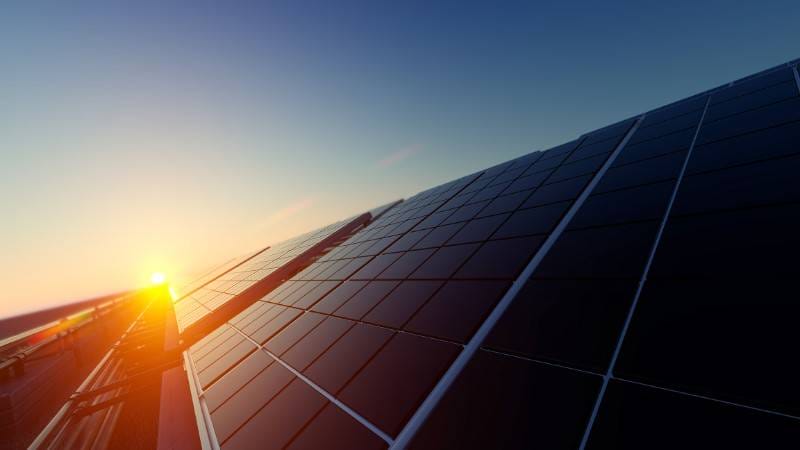A great thing about solar panels is that they keep working all day. It doesn’t matter if the sun’s just risen, or just about to set — your panels will pick whatever light is reflected from the atmosphere or the ground. They even work when it’s cloudy.
But what would you say if I tell you there are solar panels that pick up sunlight from the underside too and deliver up to 30% more energy?
Bifacial solar panels use the technology of active solar cells on both sides, so they can pick the solar energy that is “coming” from below.
Using my expertise as an electrical engineer and experience with different types of solar panels, I decided to try and evaluate the bifacial technology and tell you if they are worth it at the end of the day.
What Are Bifacial Solar Panels?
Bifacial solar panels are double-sided panels that use both the top and bottom sides to capture and transform the solar energy.
They’ve been around since they were first used in the Soviet space program in the 1970s but they were too expensive to produce for utility-scale projects.
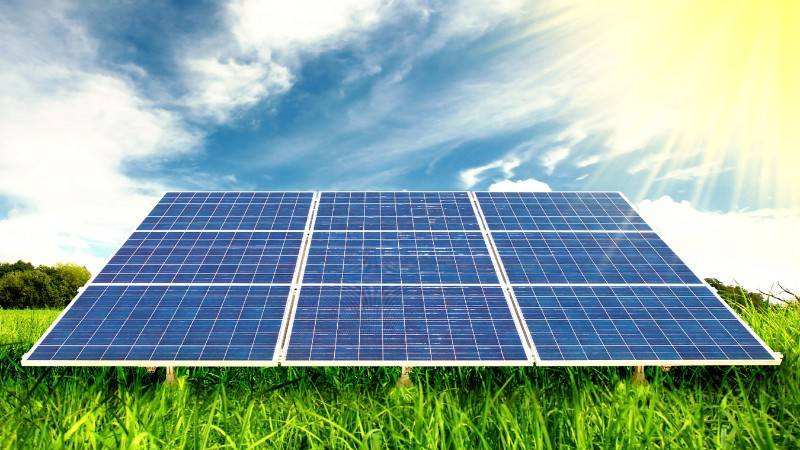
The good news is it’s much cheaper to manufacture them now, which means that ordinary people like you can already have access to them.
Bifacial panels are much slimmer than their monofacial counterparts and often have no frames. The top of each panel is covered with protective glass, while the flipside is either glass or a clear back sheet.
Why Use Bifacial Solar Panels?
Bifacial solar panels have many advantages to traditional single-sided panels.
For example, they are a great choice if you are short on space. You get more solar energy for the same solar panel size and for only a bit higher installation costs.
As they are designed to collect sunlight from both sides, bifacial modules are typically raised from the surface. An added bonus of this kind of installation is that there’s more airflow for better cooling.
Another great thing is they’re also often more durable because both of their sides are UV-resistant.
Perhaps the most interesting benefit for you is that you can install frameless bifacial solar panels in many different configurations — You can use them with raised roof mounts or with ground mounts that allow them to be tilted at different angles for better exposure.
This means you can use bifacial panels for both commercial and residential sites.
Finally, since they are transparent and relatively slim, bifacial panels can be beautifully integrated into various aesthetic and architectural elements such as canopies, pergolas, and sun-breakers.
How Does A Bifacial Solar Panel Work?
The top solar cells of a bifacial solar panel face the sun so they can absorb the available sun rays directly. This makes it no different than a conventional solar panel in this sense.
The bottom cells, however, are designed to absorb reflected light. This means that unlike conventional one-sided panels, bifacial panels produce more energy when you angle them to a white roof or to the ground.
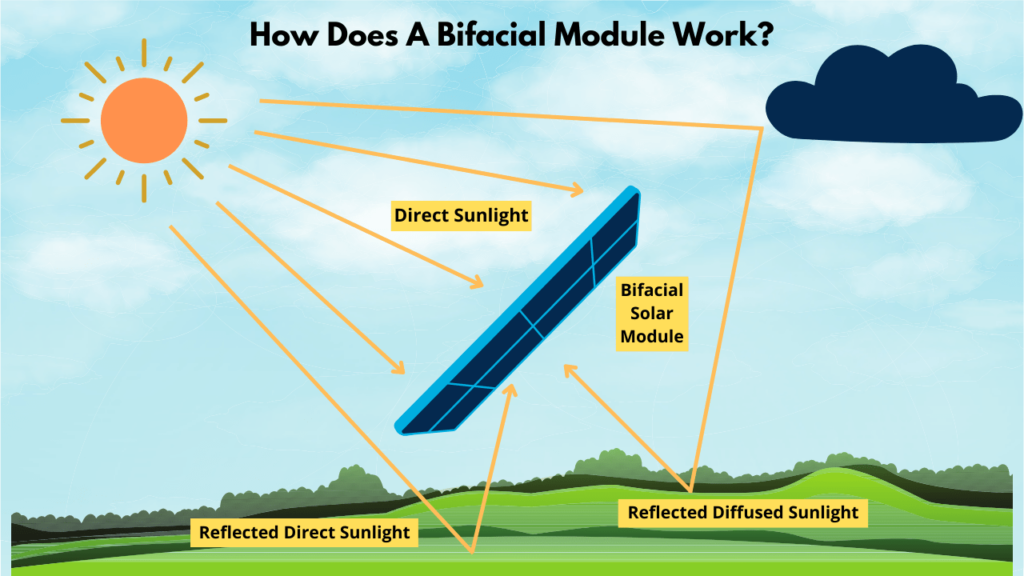
Even more amazing is that since bifacial panels maximize on light reflection, they are even more productive on cloudy days when the light is already diffused.
You can take advantage of this and tilt half of your panels facing east and the second half facing west. This way you’re covered for the whole day, as your panels capture both morning rays and the afternoon peak.
At the same time, the panels’ backsides are doing their part by soaking the solar energy that “comes” from the other side.
You can also place your bifacials vertically.
In this setup, you also have two energy peaks each day. The sun-facing side “works at full steam” during each peak, while the other side harvests the reflected light.
Types of Bifacial Solar Cells (BSC)
Bifacial solar cells (BSC) are photovoltaic solar cells that produce electrical energy when exposed to the sun on both front and rear sides.
This is why the efficiency of bifacial solar cells — the ratio of available sunlight power to generated electrical power — is measured independently for the front and rear side under one or several suns.
1 sun = 1000W/m2
Another important figure is the bifaciality factor, which is the ratio of rear efficiency in relation to the front efficiency under the same solar irradiance. X 100
Bifaciality factor (%) = η(front) / η(rear) ✕ 100
Different bifacial solar modules use different architectures for their BSCs.
These include,
- Passivated Emitter Rear Contact (PERC)
- Passivated Emitter Rear Locally-diffused (PERL)
- Passivated Emitter Rear Totally diffused (PERT)
- Heterojunction with Intrinsic Thin-layer (HIT)
- Interdigitated Back Contact (IBC)
Let’s quickly point out the perks of each BSC type.
PERC
- Efficiency: 9.4–21.2% front surface, 16.7–18.1% rear surface.
- Bifaciality Factor: 70-80%
- Usage: Mostly commercial with brands like JA Solar, LONGi, and Trina.
PERL
- Efficiency: 19.8% front surface, 17.6% rear surface
- Bifaciality Factor: 80-90%
- Usage: Mostly commercial with brands like Sinovoltaic
PERT
- Efficiency: 19.5–22% front surface, 17–19% rear surface
- Bifaciality Factor: 80-90%
- Usage: Mostly commercial with brands like LG, Trina, and Yingli
HIT
- Efficiency: 24.7% front surface, 18.4 % rear surface
- Bifaciality Factor: 95-100%
- Usage: Commercial with brands like Sanyo
IBC
- Efficiency: 23.2%
- Bifaciality Factor: 70-80%
- Usage: Commercial with brands like SunPower
How to Install Bifacial Solar Panels
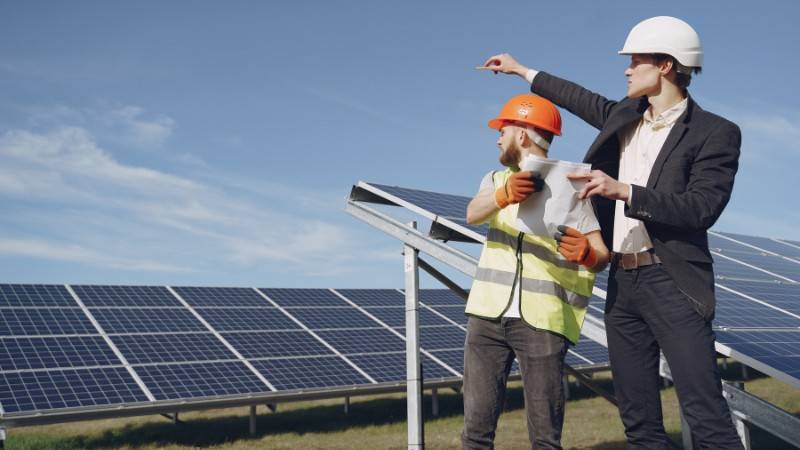
On the other hand, most bifacial panel manufacturers include their own clamps to mount their products, so the installation becomes pretty much straightforward.
When you purchase frameless bifacial solar panels, the clamps often come with rubber guards that protect the glass.
When setting up this type of panel, installers must take care not to overtighten the bolts and damage the glass.
The more a bifacial solar panel is tilted, the more energy it delivers. That’s why you should always use them on either a flat rooftop or ground-mounted arrays which offer a lot of room for tilting and for the reflected light to bounce to the rear end of the module.
As they are designed to collect sunlight from both sides, bifacial modules are typically raised from the surface. This means that there’s less chance of them overheating.
Finally, you need to know that the supporting structure can affect the performance of your bifacial panels.
Mounts with support rails that are covered by a single-facial module’s backplate will shade the bottom-side bifacial cells.
This is why you should go with mounting and racking systems that are specially designed for bifacial installation.

Read More:
How Much Do Bifacial Solar Panels Cost?
Bifacial solar panels cost a little more than traditional single-sided panels. However, since they work double time, you can achieve the same power capacity with fewer panels.
The average cost range to install bifacial solar panels in the US is $6,000 to $12,000. According to Fixr, most people pay around $8,000 for 10 bifacial solar panels in a porch cover configuration.
If you’re looking to mount 10 bifacial panels around the edge of your home, that will cost you around $5,000.
On the other hand, if you plan for a moving mount that allows the panel to capture more light, a 10-bifacials project will set you back $14,000.
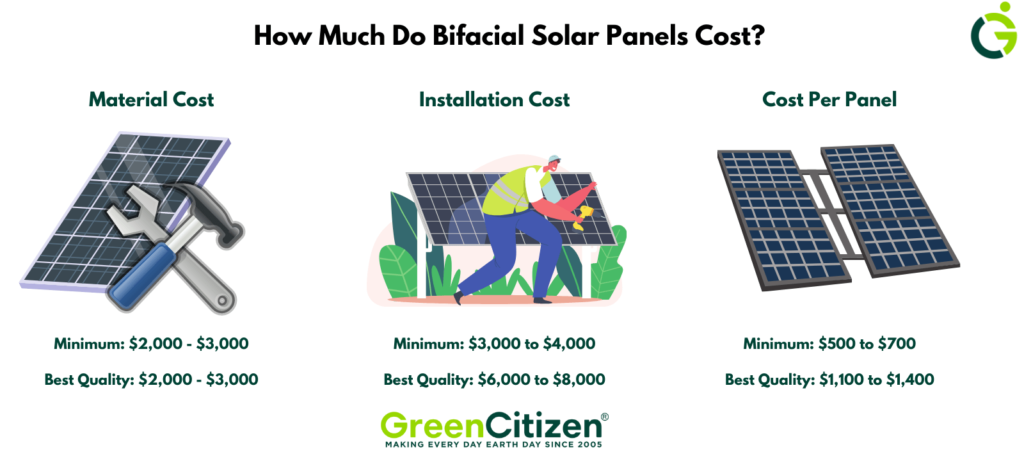
So what am I actually paying for?
- Materials: Anywhere from $2,000 to $3,000 for the basic materials and $5,000 to $6,000 for the best quality products.
- Installation: Labor costs for a simple rooftop mount go from $3,000 to $4,000. Ground mounts cost more to make, from $6,000 to $8,000.
- Cost per panel: Low end panels cost from $500 to $700, while top shelf models go for $1,100 to $1,400.
Keep in mind that polycrystalline panels are the least expensive, while frameless monocrystalline panels are the most expensive option, but also the most versatile and efficient.
The bifacial solar panels price also grows with the wattage. But the more watts the more energy the panel produces, which means more savings on your energy bills.
Bifacial vs Monofacial: How Efficient Are Bifacial Solar Panels?
The efficiency of solar panels is the capability of a solar cell to convert the total amount of solar energy into electrical energy.
In a 2018 study by LONGi Solar, it was discovered that bifacial solar systems can increase the efficiency by 11% of that of traditional solar panels.
The latest generation of SunPower Performance bifacial panels uses aviation-grade conductors for cell connections, resulting in even greater gains while maximizing the active area. These engineering upgrades amount to about 32% more energy over 25 years.
But can their efficiency be increased even more?
The answer is yes, you can increase their productivity by as high as 27% if you go with a solar tracking system that keeps tilting solar cells toward the sun as it makes its way across the sky.
Such a system is constantly aiming for the maximum direct exposure by keeping the panels perpendicular to the sun at all times.
To achieve the same amount of solar power, you’d need more monofacial panels.
Check out the comparison of efficiencies between the most popular commercial solar panel types today:
| Type of Solar Panel | Total Solar Cell Efficiency |
|---|---|
| Monofacial Monocrystalline | 18% and above |
| Monofacial Polycrystalline | 15–17% |
| Monofacial Thin-Film | 11–15% |
| Bifacial Monocrystalline | 20% and above |
However, the real efficiency of different types of solar panels also depends on your latitude.
Monofacial solar systems are more cost-effective at latitudes below 40° because these regions have low reflected light, or albedo light.
Bifacial solar systems, on the other hand, are more effective at latitudes beyond 40°.
At latitudes beyond 65°, bifacials can reach a whopping 71% increase in energy production.
Pros and Cons of Using Bifacial Solar Panels
Bifacial solar panels are becoming popular due to their uncontested efficiency and the resulting ability to squeeze more solar power with fewer units. But what are the shortcomings of bifacial technology?
Advantages of Bifacial Solar Panels
Higher Efficiency
Bifacial solar modules use both sides of the panel to produce energy. Manufacturers say that bifacial solar panels can generate up to 30% more energy than monofacial panels. Great news for those with limited roof space.
Durability
Most bifacial panels are frameless and covered by tempered glass on both sides. This tempered glass is weather-resistant, UV resistant, and able to withstand high temperatures. As a result, bifacial solar panels are expected to last longer.
Aesthetics
Bifacial modules are manufactured in many designs, many of which don’t have aluminum frames. Frameless bifacial solar panels are considered more aesthetically pleasing by many.
Cloud-Friendly
The active surface on the rear side means that bifacial solar panels perform better in diffuse light, such as the overcast weather. This makes them more cost-effective in the long term than monofacial modules.
Reduced PID
In case of frameless bifacial panels, the solar cells are less prone to potential-induced degradation (PID). This is a phenomenon where electrical currents diverge from their intended path and cause corrosion from within. What is more, bifacial panels with no metal frames require no grounding either.
Warranty
Bifacial panels regularly come with longer warranties of up to 30 years.
Disadvantages of Bifacial Solar Panels
Initial Costs
A more complex manufacturing process makes bifacial solar panels up to 10% more expensive than monofacial counterparts.
Installation Costs
Thanks to the double-glazing, bifacial solar panels are heavier and require specialized equipment to install, raising the labor and material costs.
Less Flexible
To take the full advantage of double-sided solar cells, bifacial solar panels work best when they are at least four meters from the ground. In the case of roof mounts this means using a raised platform that allows the bottom side to collect reflected sun rays.
This might not be possible in all residential settings, leaving bifacial panels more suitable for solar farms or off-grid systems. However, you can use them as an awning or lean-to roof.
So, let’s summarize,
Pros
Cons
- More efficient than single-sided panels
- More durable
- Aesthetically-pleasing
- Perform better in overcast weather
- Slower degradation
- Longer warranty
- More expensive to produce
- More expensive to install
- Require special mounts
How to Know if Bifacial Solar Panels are Right for You
To decide whether you can benefit from bifacial solar, you need to consider your site’s surface reflectivity or albedo potential and the available tilt angle first.
Metal roofs and white roofs are great reflectors, so if you have one of these, you should definitely consider bifacials.
If you live in an area with a lot of snow, you should consider a bifacial ground mount, because snow is one of nature’s most reflective materials.
And you know what the best part is? Bifacials will keep producing electricity even when their top side is covered with snow!
The more vertical your bifacial panels are, the more light reaches the backside, and the more energy they can produce. This is why bifacial panels might be the best choice if you have a flat roof or enough room in your backyard for a ground mount.
If you’re still undecided, here’s a quick questionnaire. If you answer at least two of these questions with “yes,” then a bifacial system is great for you.
- Do you have space for a ground-mount system on your property?
- Is there snow cover on your property for most of the year?
- Is there a sandy area on your property? (Would you create a mini-desert?)
- Would you like to create one or several pergolas or awnings?
- Is your roof white or silver or could you paint it or cover it with white or silver shingles?

Read More:
Are Bifacial Panels a Good Choice for Homes?
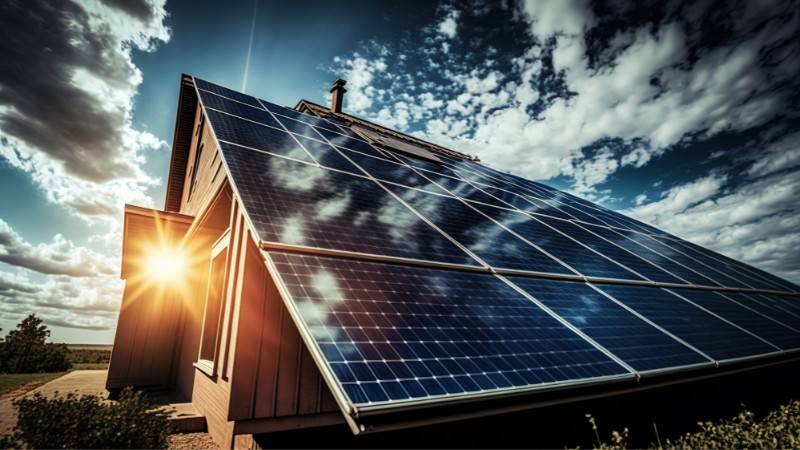
The short answer is no.
Bifacial solar panels don’t perform to the maximum when installed on rooftops. Standard rooftop frames leave just a few inches between the panel and the roof surface.
As a result, reflected sunlight can’t reach the rear panel surface. This leaves the front side to do all the work, which effectively turns it into a monofacial panel.
You could theoretically raise the panels on a higher rooftop mounts, but the question is would your homeowners’ association would allow it.
Besides, bifacial solar panels are more expensive than regular ones, and it’s less likely that a home installation will produce the additional solar energy that justified the bifacial solar panels price.
Traditional monocrystalline or polycrystalline solar panels are still the most cost-effective option for home solar systems.
On the bright side (pardon the pun), there are residential scenarios where bifacial solar panels feel right at home (another one).
You can use them as covering for freestanding structures like carports, awnings, and pergolas. In all these cases, bifacial panels provide a durable protection against rain, while providing partial shade and producing energy from both sides.
Top Bifacial Solar Panel Manufacturers in The Market
Bifacial cell technology is still relatively new, so not all solar panel manufacturers produce bifacial modules. Until recently, LG was one of the top bifacial solar panel manufacturers, but recently they announced that they are giving up the solar panel business.
In the meantime, other bifacial solar manufacturers have stepped up to fill in the gap and now they can boast some of the best bifacial solar panels you can buy.
Canadian Solar
Canadian Solar bifacial panels combine the advanced BSC technology with double glass module manufacturing expertise.
The result are the top-of-the-line BiKu bifacial panels which are used for utility-scale projects. These panels have frames made of durable anodized aluminum alloy covered with 2 mm of tempered glass.
Canadian Solar claims that BiKu panels yield up to 30% additional power from the rear side.
Jinko Solar
This manufacturer is known for its Tiger model LM bifacial solar that comes with a 13-year manufacturing warranty, 30-year linear power warranty, and a claimed 0.45% degradation rate.
Using the unique frameless design, Jinko solar panels also have the reduced possibility of the PID effect.
Q CELLS
Q CELLS manufactures bifacial solar panels for utility-scale installations. One of their top-shelf models, the QPeak XL Duo has an efficiency rating of 21.4% and comes with a 12-year warranty for the product and 25-year warranty for performance.
LONGi Solar
This manufacturer is known for its high-end features in their modules, such as PERC technology used in their Hi-MO 5 Bifacial Series. Using an additional layer of glass on the backsheet, these panels help reduce energy loss and turn more sunlight into electricity.
Trina Solar
The quality of Trina Solar panels, financial visibility on Shanghai Stock, and long-lasting value earned this China-based company a spot among Tier-1 manufacturers.
Their Duomax Twin is a 252-cell monocrystalline bifacial solar panel with excellent temperature coefficients and Multi Busbar technology that gives it the efficiency of 20.6%.
Yingli Solar
In business since 1998, Yingli Solar is one of the oldest renewable manufacturers today. The company covers the entire production process for its panels, from the raw materials that go into silicon cells, to aluminum, to glass backsheets.
Their YLM GG bifacial modules have a high yield thanks to the low LID (Light Induced Degradation) and the temperature coefficient — a whopping 22.5%.
What’s The Future for Bifacial Solar Modules?
Although bifacial technology has been present for as long as monofacial technology, it has started to attract a lot of attention in recent years due to higher efficiencies and reduced manufacturing costs.
According to a report, the total installed capacity of bifacial solar modules is expected to reach 20,000 MW in 2024 globally, making up 17% of the PV market.
The International Technology Roadmap for Photovoltaic (ITRPV ) predicted that the market share of bifacial modules will increase by at least 35% by 2030.
More recent studies, however, show an increased interest for bifacial technology, so much as to predict a market share of 70% in 2030.
If you think this is too good to be true, listen to this:
Data by pvDesign, an app for designing PV plants, show that the number of users who used bifacial modules in their simulations has doubled from 2020 to 2021.
Countries with the greatest deployment of solar plants with bifacial modules are China, Chile, Mexico and the Middle East.
There is little doubt that the industry will keep seeing new solar developments with bifacial technology in the future. The main question is whether the industry will be able to deal with the same challenges that traditional solar and wind faced in 2000s — standardization, bifacial technology gain simulations, and bankability.
Solar bankability refers to the willingness of your bank to finance your solar project with the products you selected because they are confident about the quality of the module and the solid state of the manufacturer.
Are Bifacial Solar Panels Worth It?
Yes, bifacial solar panels are worth it. With solar cells on the rear side as well, they increase the power you can gain by collecting sunlight that reflects from the surrounding surfaces.
You can maximize bifacial modules’ output by installing them on a solar tracking system that keeps them tilted towards the sun all the time.
However, they are not suitable for residential use at this point. The tall mounts are not convenient for suburban roofs and backyards. Also, the higher upfront costs are difficult to cover with a home-size solar system even in the long term.
If you’re looking for solar panels for home, quality one-sided monocrystalline panels are still your best choice.
